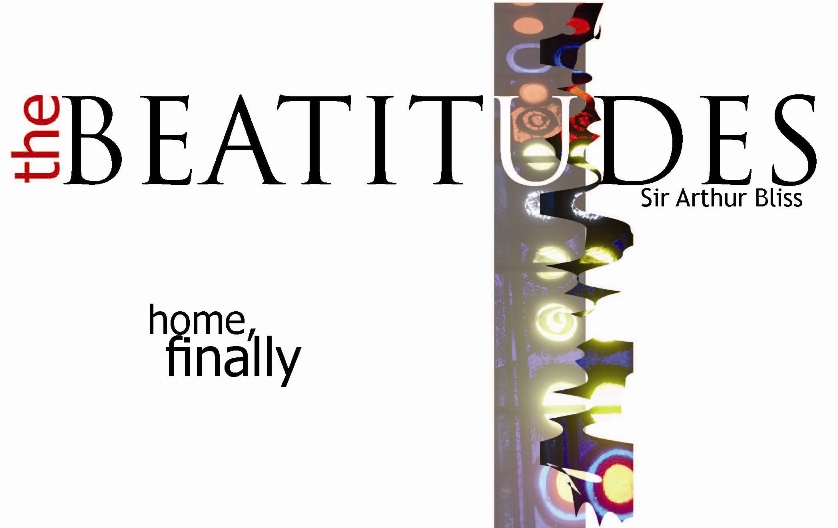Bliss's cantata The Beatitudes was commissioned to mark the opening of the new Coventry Cathedral in 1962.
As the building of the cathedral was an act of reconciliation for the destruction of the old cathedral during the bombing of the city in the Second World War, the choice of the Beatitudes as a theme for the work was highly appropriate. Significantly it is dedicated to a representative of the postwar generation, the composer's first grandchild, Susan, born in 1955.
The premiere was fraught with difficulties.
Because of scheduling relating to the opening services and rehearsals for other events - mainly the first performance of Britten's War Requiem - it proved impossible to perform The Beatitudes in the cathedral as planned. Instead, it was performed, most unsuitably, in the cramped and acoustically poor conditions of Coventry Theatre on the evening of 25 May, some hours after the consecration of the cathedral.
The soloists were Jennifer Vyvyan and Richard Lewis with the Coventry Cathedral Festival Choir and the BBC Symphony Orchestra, conducted by the composer himself.
Bliss was concerned that in setting the Beatitudes there was the danger of monotony so formed a masterful collaboration with Christopher Hassall (librettist) with whom he had worked previously. Hassall suggested the idea of the Beatitudes as the subject of the work and conceived the choice of texts, which would act as interludes and commentaries on them.
Bliss wrote in his autobiography As I Remember: ' ... each Beatitude shines with the same clear silver gleam, and little contrast of light is possible without deliberately using a distorted mirror’.
He varied their setting by grouping the first two and penultimate four Beatitudes together. However, he felt that further contrast was needed, so he planned to express a mood of violence – ‘force’, he commented, opposing the beatific vision. He did this four times within the work.
Overall, Bliss suggests that in the conflict of contemporary life, the meaning of the Beatitudes has been lost or ignored, as emphasised by a quotation from John Donne’s The Storm which heads the work:
‘…we, except God say
Another Fiat, shall have no more day.’
50 years after its composition the work's message is still valid.
Using an anthology of texts as a means of providing a structure for a work was a device Bliss had used several times before, for example in Morning Heroes.
Here, the texts comprise the Beatitudes themselves, a passage from the Old Testament, the writings of three great 17th century metaphysical authors, Henry Vaughan, George Herbert and Jeremy Taylor, and one modem master, Dylan Thomas.
[ Left - 3 great poets of Wales;
300 years of Welsh literature
... superbly combined for The Beatitudes. ]
What an extraordinary combination...
They form a logical and dramatic sequence that reaches a climax in the outburst of violent hatred personified by the 'Voices of the mob' and in Taylor
The work has many high spots: for example, the anguished orchestral prelude that depicts ‘A troubled world'; and the disturbing outburst of hate of the 'Voices of the mob' ending on their shout of 'Kill!'
Such intrusions of violence contrast with the setting of Herbert's 'Easter', with its exultant, melismatic 'alleluias' of the soloists, and effective musical imagery at 'Awake my lute', scored for soprano and harp, followed by the lyrical tenderness of 'I got me flowers to strew thy way' into which Bliss introduces the Easter antiphon 'Haec dies quam fecit Dominus'.
Particularly memorable is the defiant mood of Thomas' 'And death shall have no dominion', Bliss's rapt response to Taylor
Consider these extreme components, pulled together by Bliss and Hassall to create a singular message for peace and reconcilliation:
Blessed are they... http://bit.ly/M9t8ij watch this You Tube video to understand Bliss' concerns about their being "...little contrasts of light...".
Now, meet one of the interludes so vividly created by "...using a distorted mirror.": http://bit.ly/M9unxZ (another You Tube video illustrating the depressive reality of a setting to which Thomas' And death shall have no dominion is so often set).
For more information read on...
(Short code to Coventry Cathedral website)





No comments:
Post a Comment